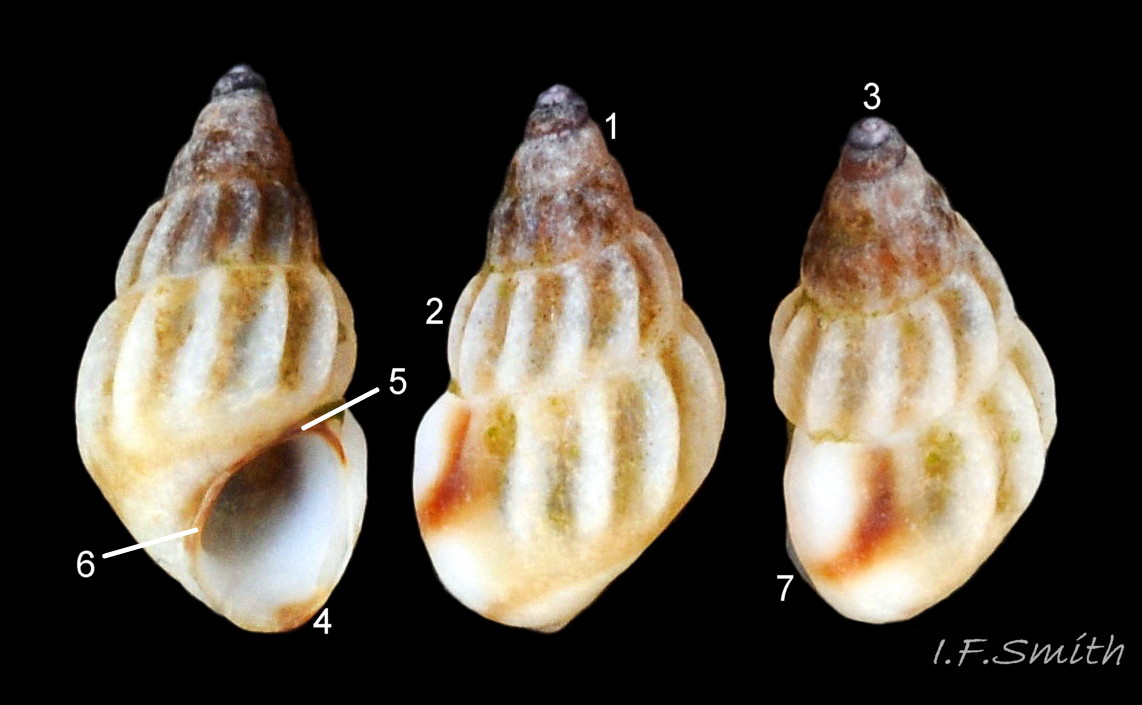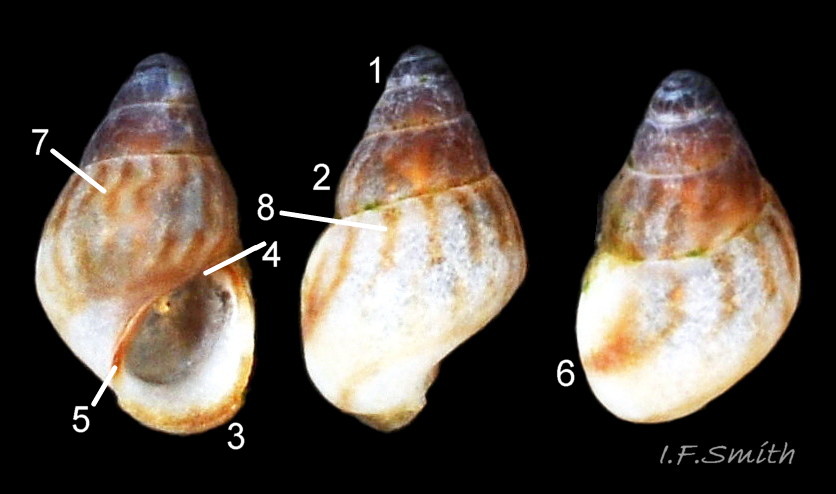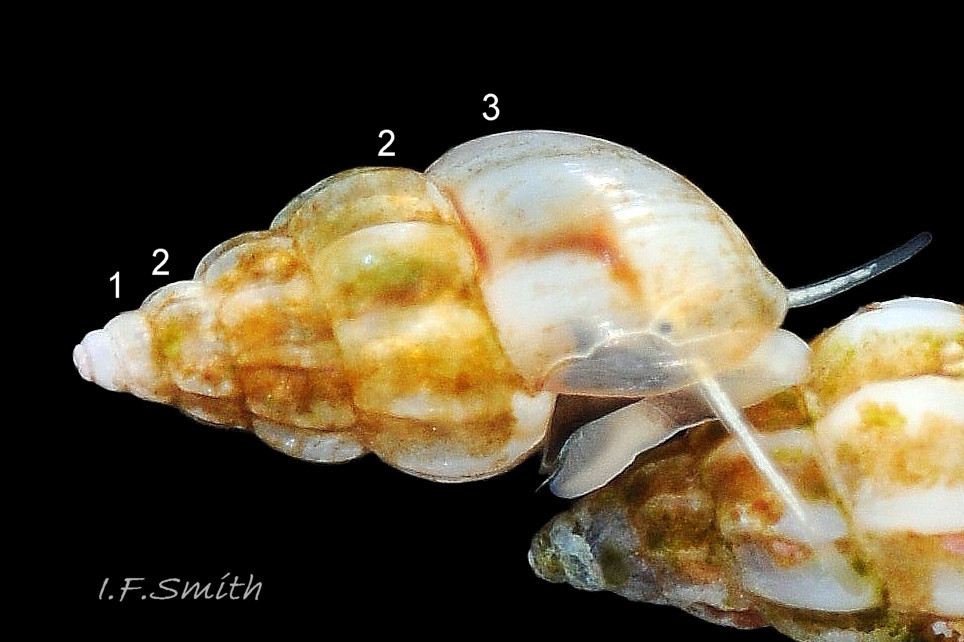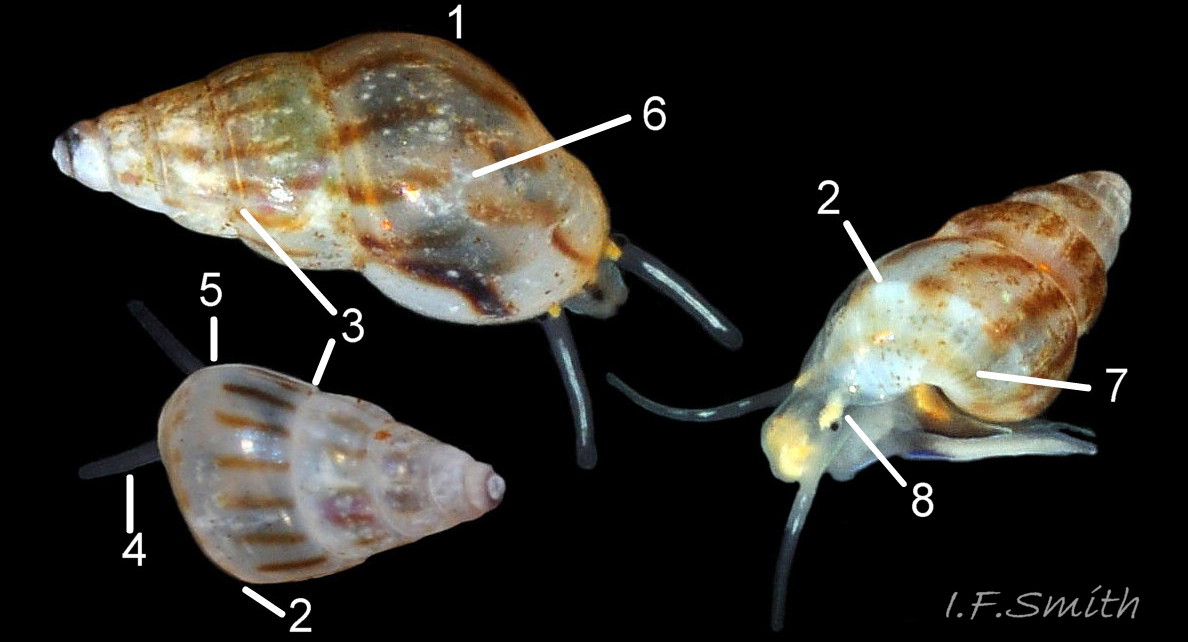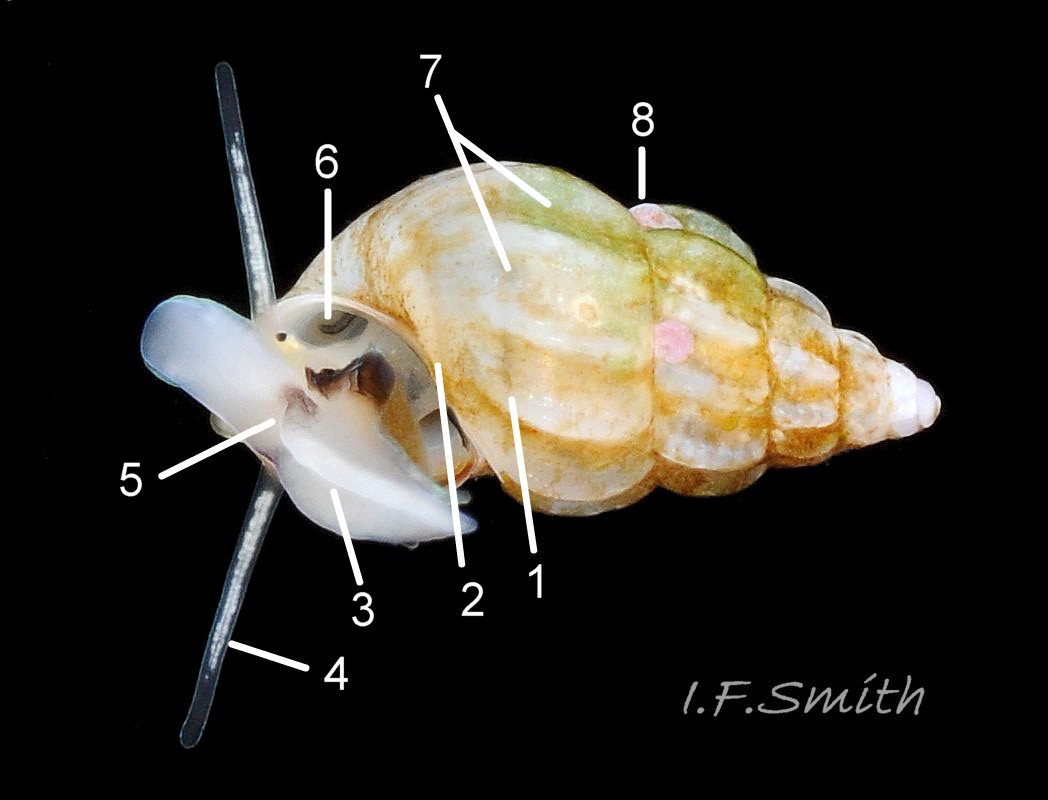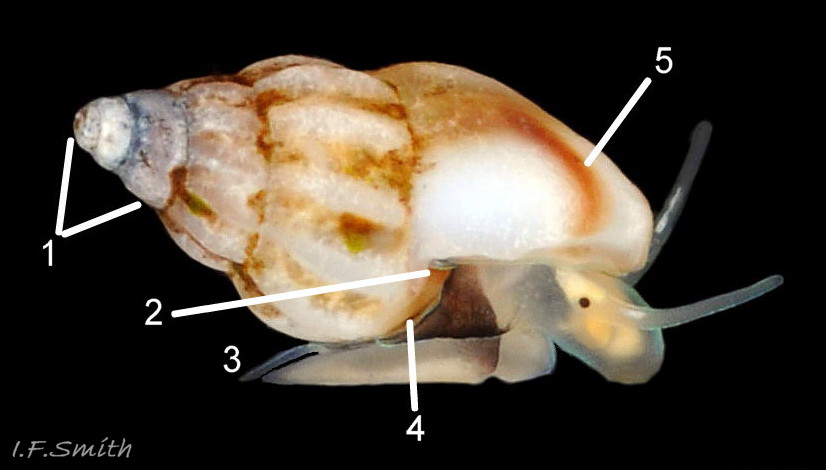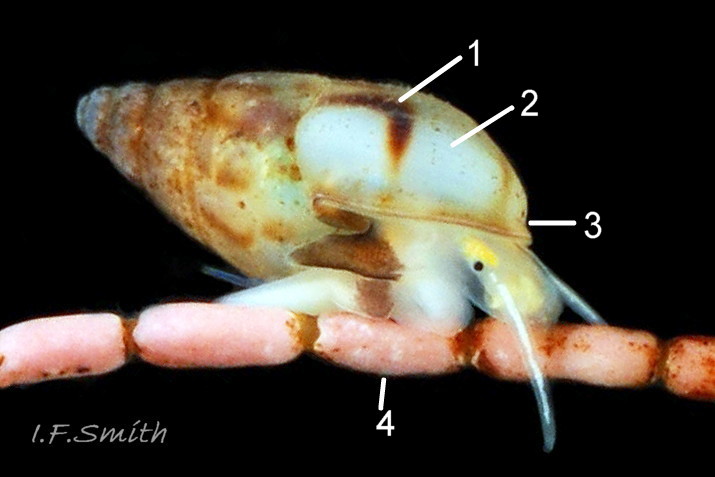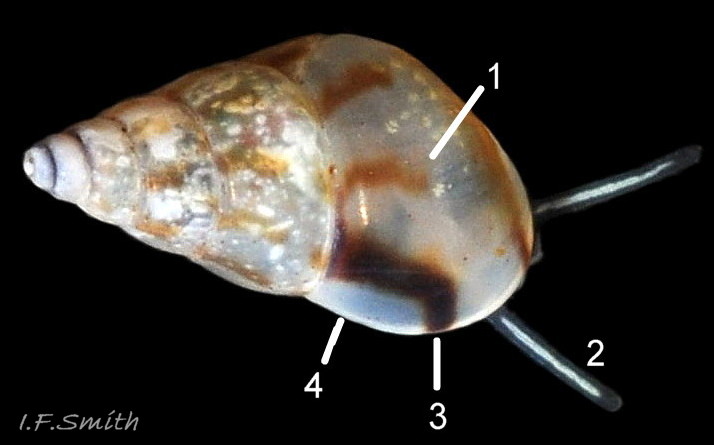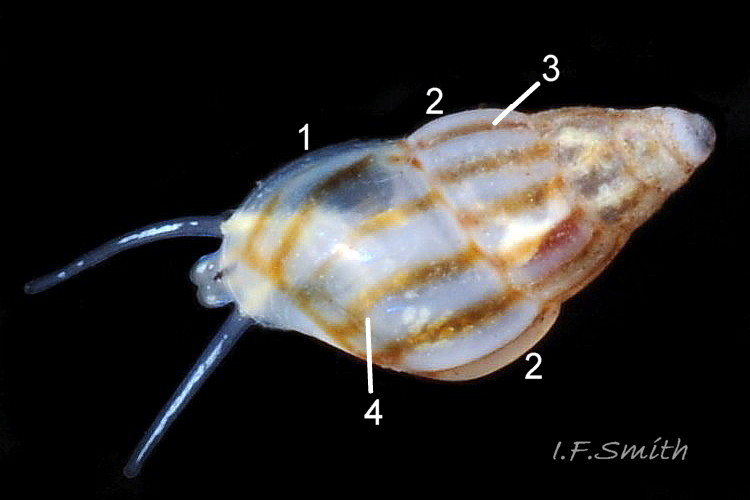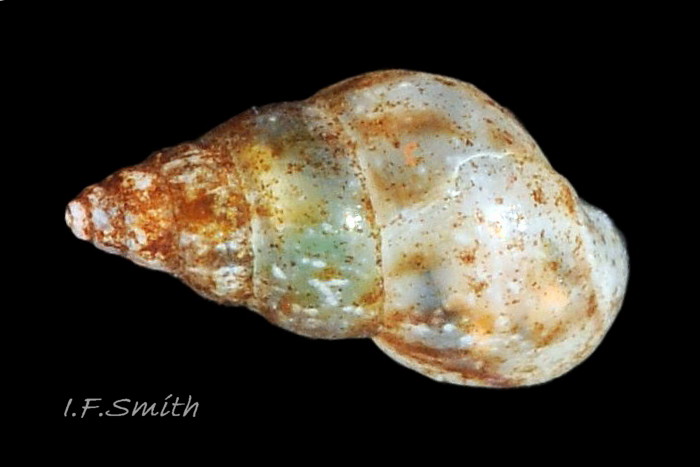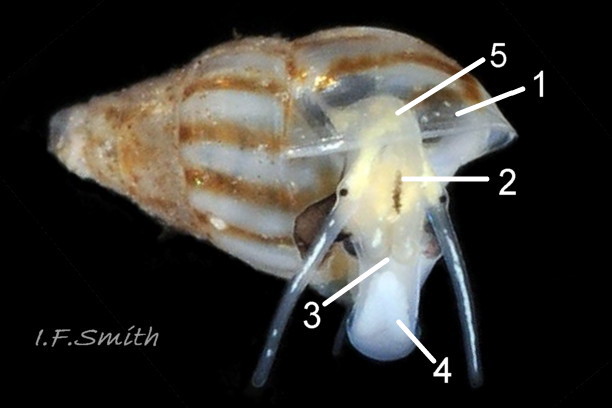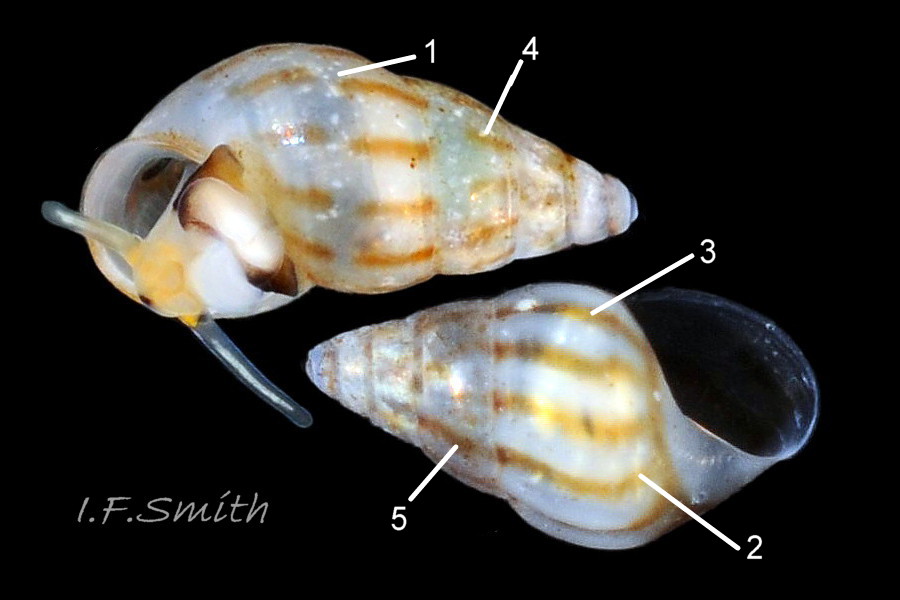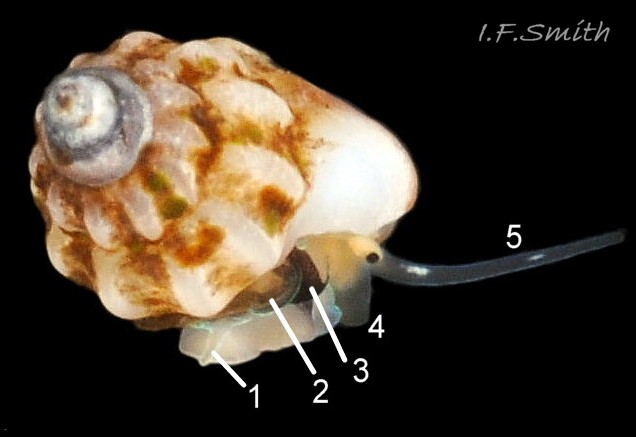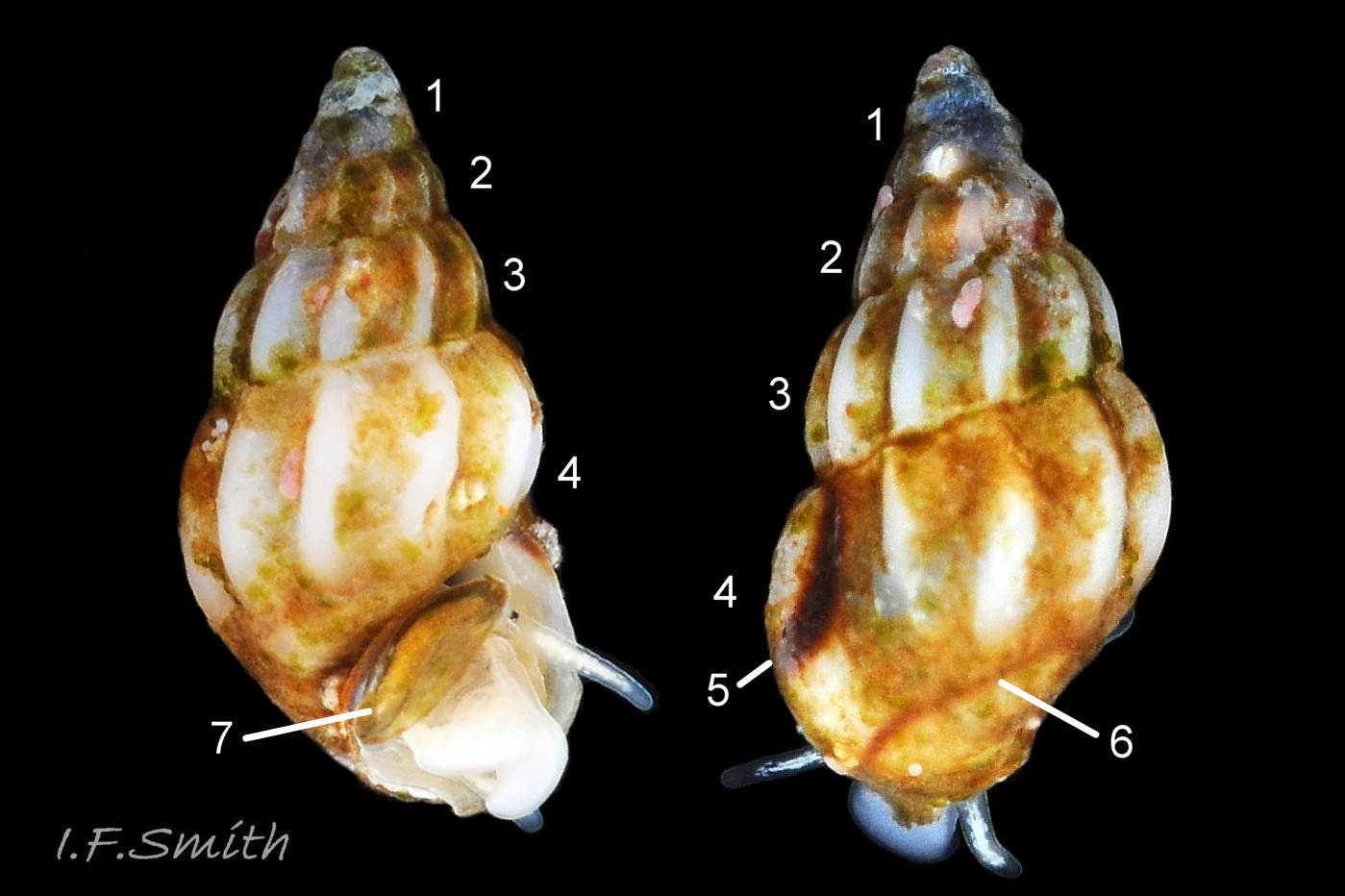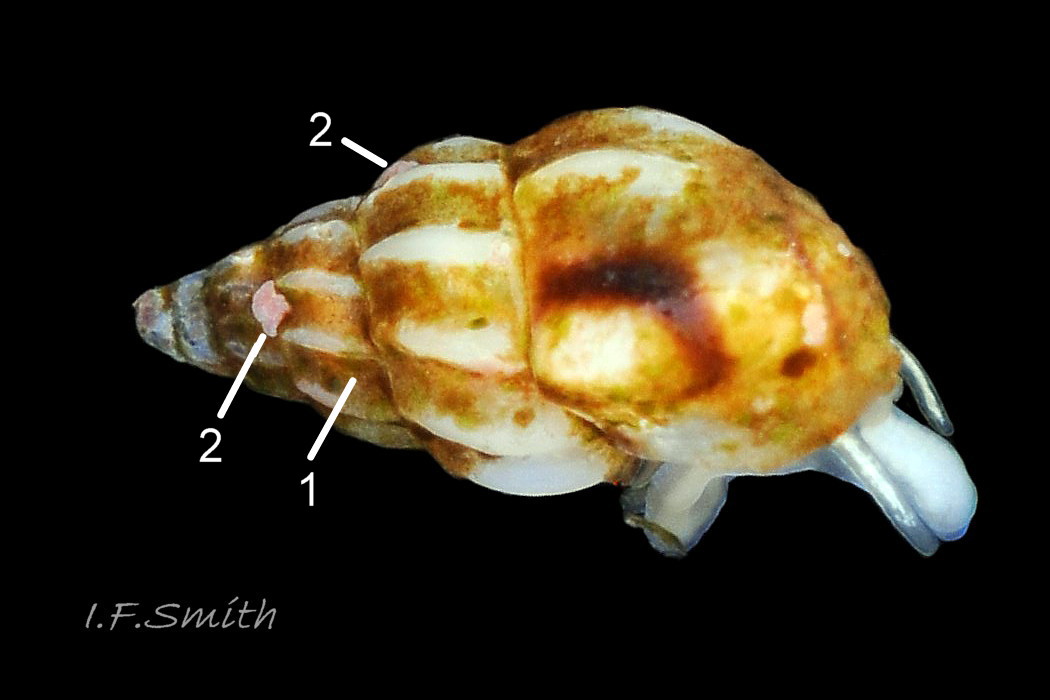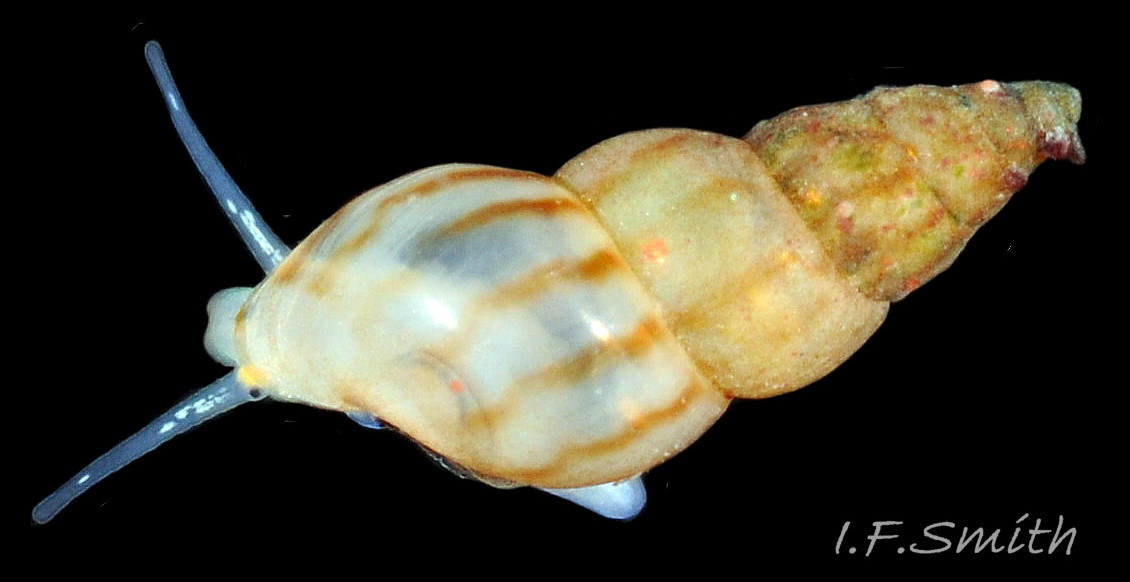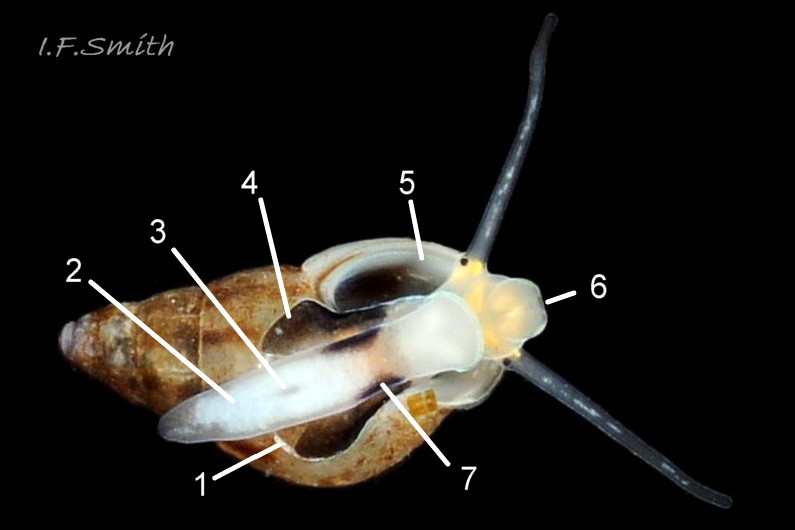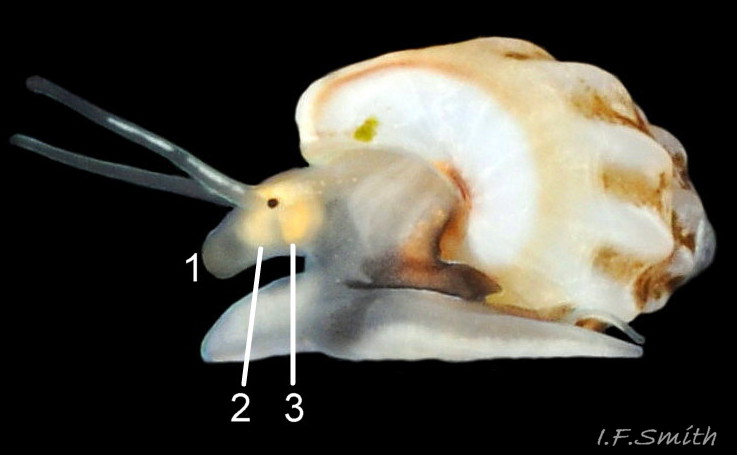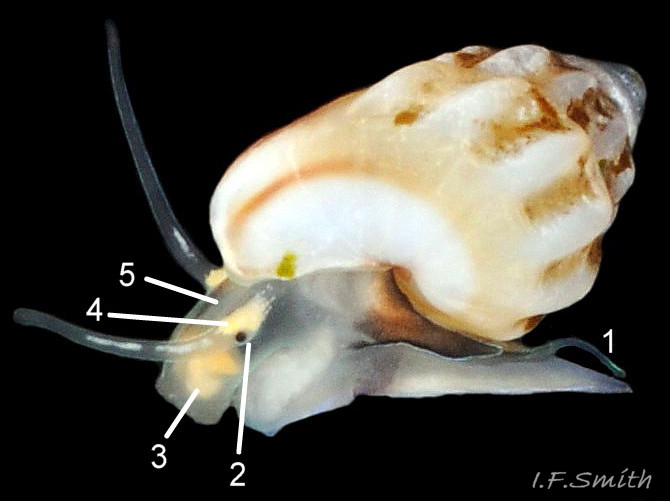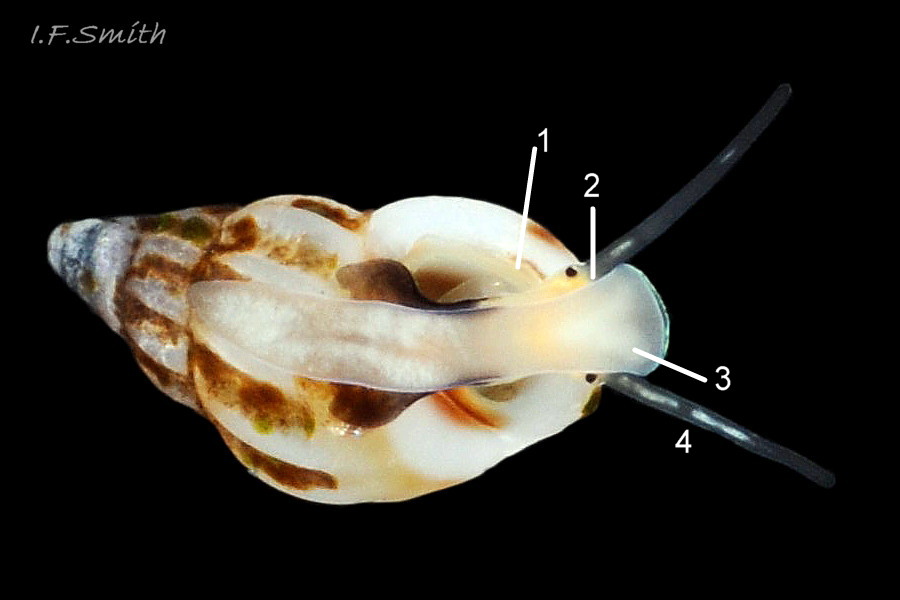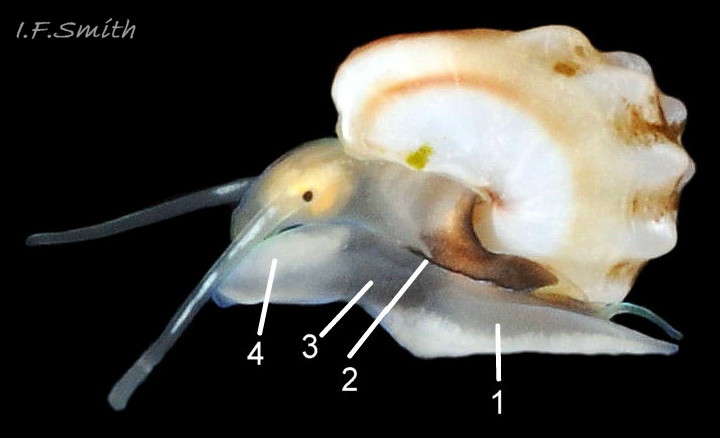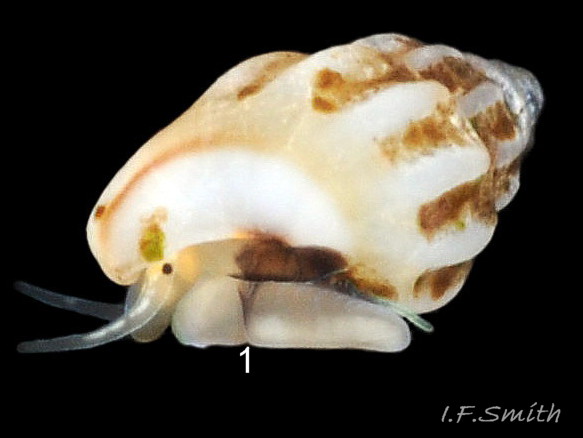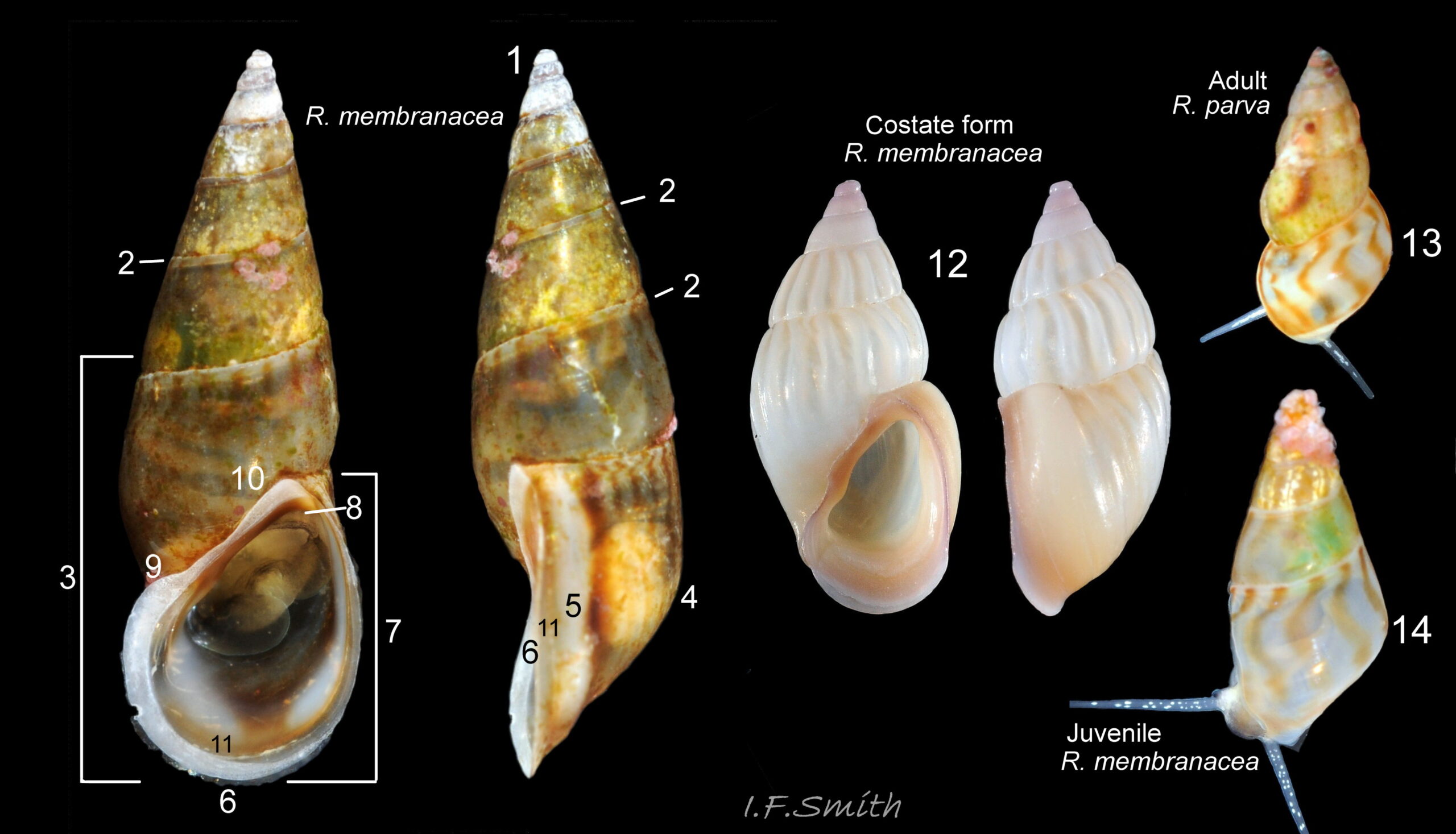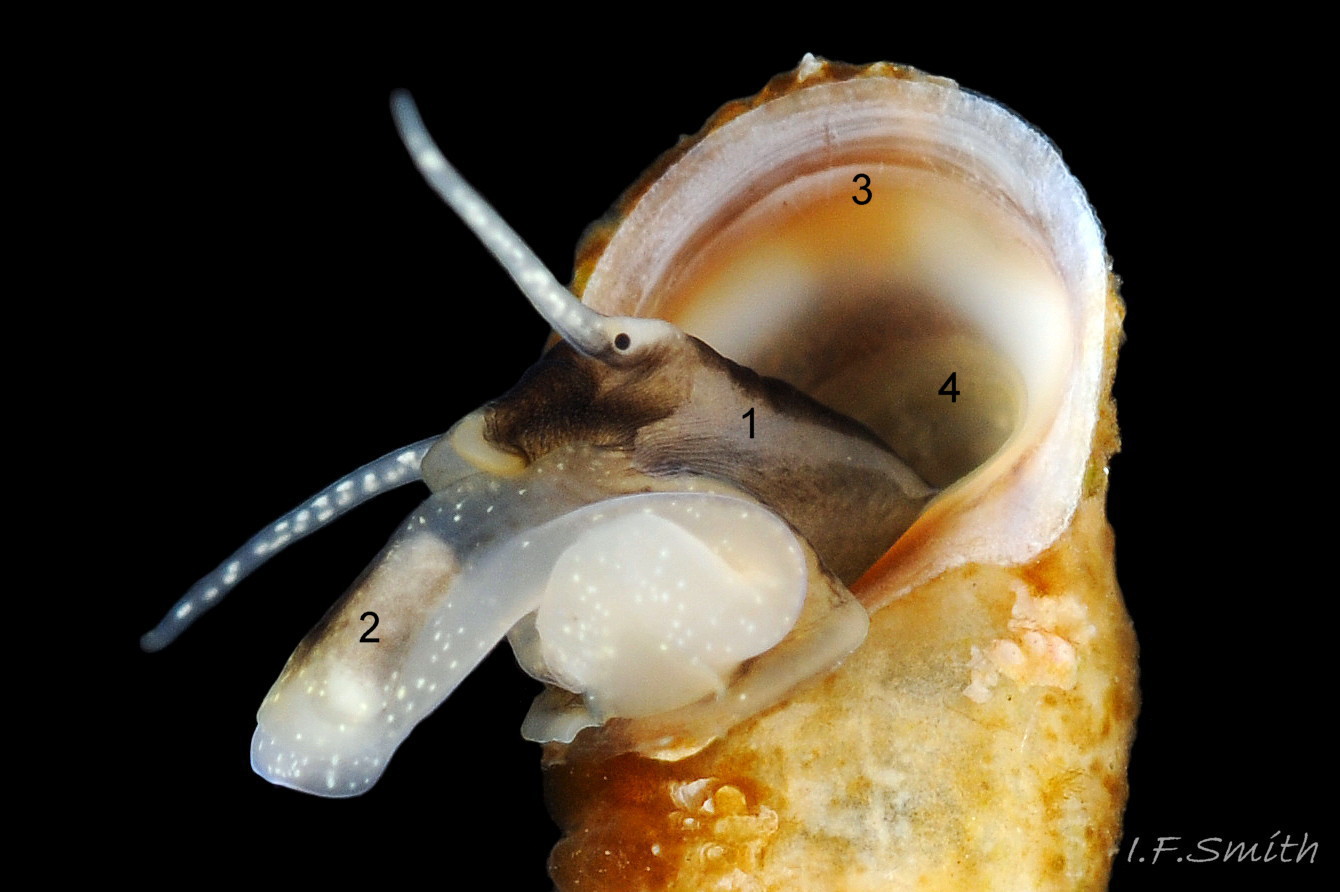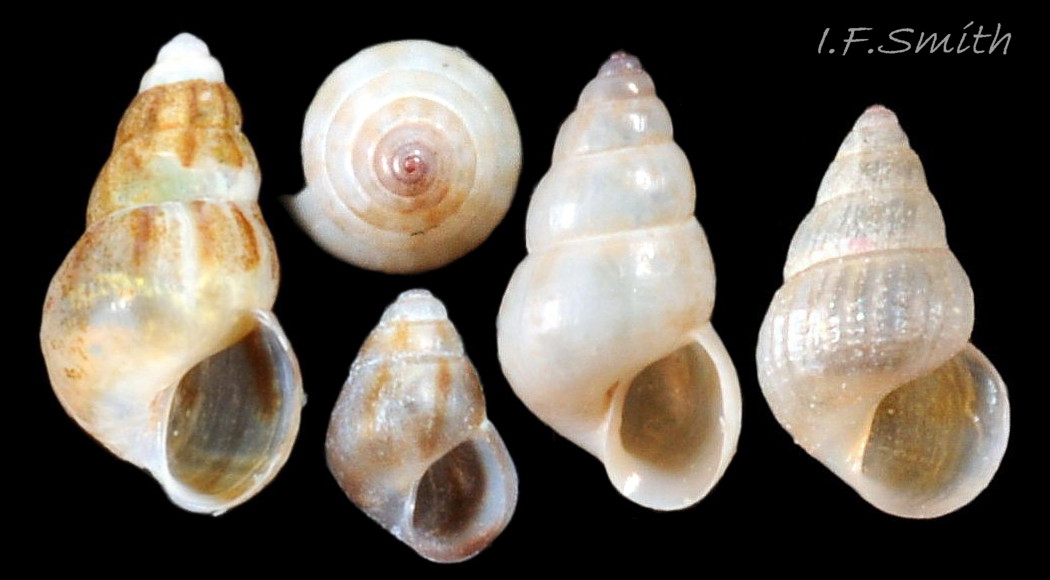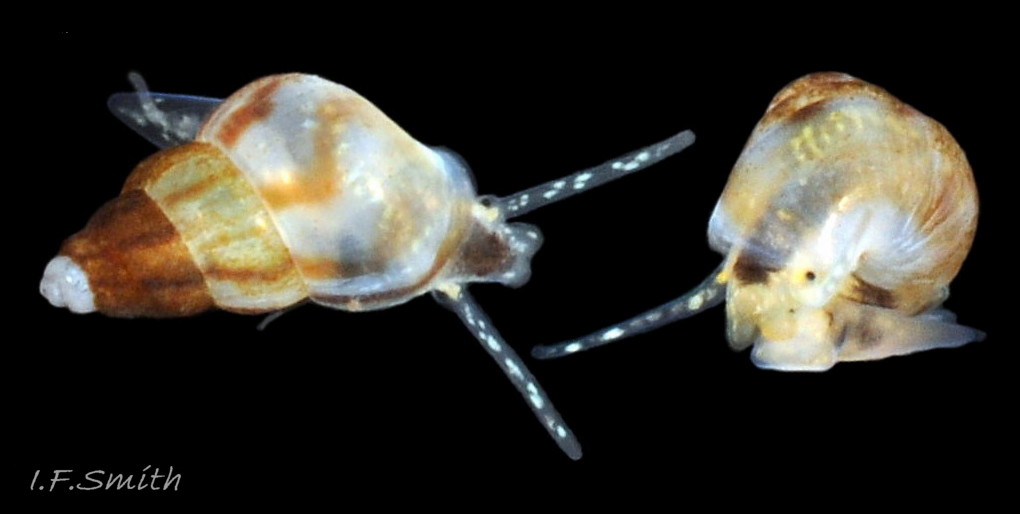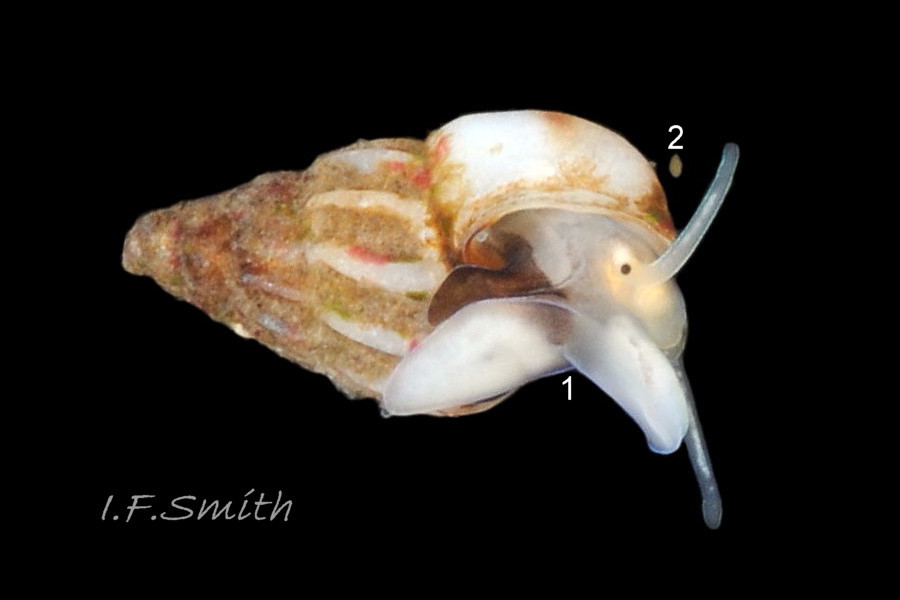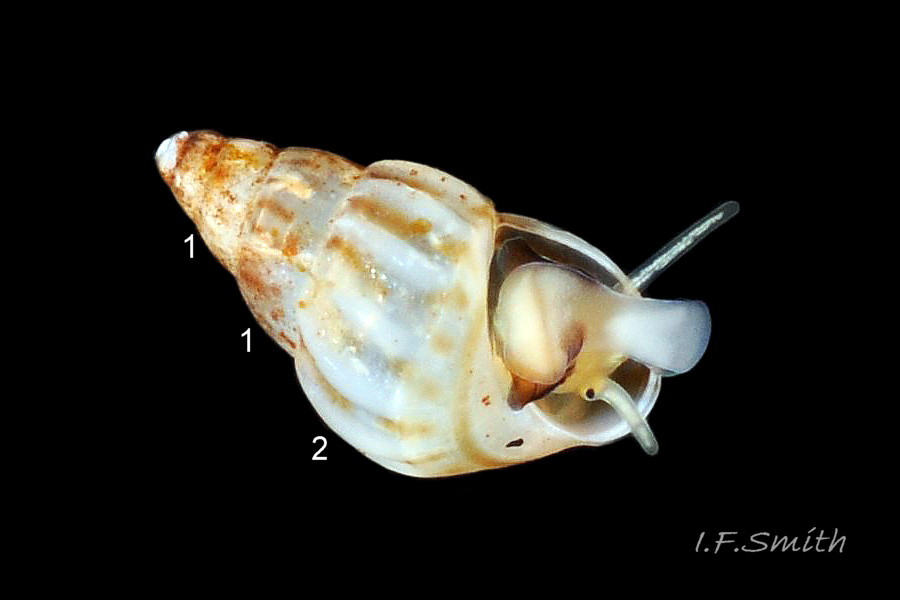Click image to enlarge with full caption. Main text below slider.
Rissoa parva (da Costa, 1778)
Synonyms: Turbo parvus (da Costa, 1778); Turboella parva (da Costa, 1778); Rissoa interrupta ( J. Adams, 1800)
Current taxonomy: World Register of Marine Species (WoRMS) http://www.marinespecies.org/aphia.php?p=taxdetails&id=141365
Meaning of name: Rissoa = named for G.A. Risso.
parva = (Latin) small
Vernacular: foldet tangsnegl (Danish); klein drijfhorentje (Dutch);
GLOSSARY below.
Shell description
Polymorphic; two main forms, costate 01 Rissoa parva and interrupta (non-costate) 02 Rissoa parva , with continuum of intermediate forms 03 Rissoa parva.
Usual features of all forms
Up to 5mm high and 3mm broad. Profile generally, moderately tall ; body whorl usually 63-70% shell height, with apical angle 34-44º but varies 25-50º; young profile lower. Whorls well defined by fine suture. Periphery of body whorl rounded on adults, angulated on young (4-5 whorls) 04 Rissoa parva. Sculpture: apart from costae on some, surface appears smooth, but microscopic spiral lines sometimes detectable, strongest pair of lines may form a cord a short distance below periphery 05 Rissoa parva (only very slight indications of spiral striae found on any shells examined by author). Larval protoconch occupies 2.75-4 apical whorls, always lacks costae; dirty- whitish, brownish, greyish 06 Rissoa parvaor tinted lilac. Ground colour, apart from protoconch, dingy-white to horn-colour to chocolate brown, with orange-brown costally-orientated lines varying in number and extent, sometimes absent. White labial varix on mature adults, with groove (not always visible) between varix and edge of aperture 07 Rissoa parva ; dark brown streak nearest aperture bends sharply in diagnostic falciform (sickle-blade-shape) mark across the varix 06 Rissoa parva. & 08 Rissoa parva. Juveniles lack varix; and falciform mark usually absent on shells below 2mm high 11 Rissoa parva ; on some larger shells falciform mark never develops 10 Rissoa parva. Aperture varies oval to D-shape ; usually 35-47% of shell-height; adapical angle about 90º; lips form a continuous peristome, usually marked brown 01 Rissoa parva & 02 Rissoa parva. Curved outer (palatal) lip, thickened by varix on mature specimens, thin and sometimes transparent on juveniles 11 Rissoa parva; slightly everted at base, angulated where meets columellar lip on young shells , rounded on older ones 12 Rissoa parva. Short columellar lip reflected onto body whorl, so no umbilical groove visible; distinct thin parietal lip 01 Rissoa parva. Internally, aperture white with brown exterior marks visible when shell translucent. Operculum horn-colour, translucent showing dark underlying opercular lobe 13 Rissoa parva, excentric spiral with nucleus near columellar lip when withdrawn 14 Rissoa parva.
Costate form
Moderately strong shell, old specimens sometimes thickened. Strong, slightly-curved, steep-sided, narrow-topped, white costae cross all of spire-whorls (excepting apical larval protoconch, about 1.5mm height) but only cross adapical two thirds of body-whorl, terminating sub-peripherally (at cord of two spiral striae according to most sources, but not detected on most shells examined by author) 05 Rissoa parva. Typically 8 costae on body-whorl, 12 on penultimate whorl and 12 on the antepenultimate whorl 14 Rissoa parva . Costate whorls distinctly convex, apical non-costate whorls slightly convex or almost flat 01 Rissoa parva. Microscopic spiral lines sometimes detectable in gaps between costae. Shell-surface usually opaque and matt on and between costae. Brown lines, if any, in grooves between white costae 09 Rissoa parva but often absent 05 Rissoa parva or obscured by debris/growths 15 Rissoa parva; frequently only visible brown lines are falciform mark crossing labial varix and spiral band on base of body-whorl 14 Rissoa parva.
Non-costate, interrupta form
Shell thinner and more fragile than costate form; surface usually fairly glossy and translucent 04 Rissoa parva and 16 Rissoa parva. Usually, whorls less convex than on costate form; giving narrower ,sometimes almost straight-sided, profile 04 Rissoa parva. Orange-brown lines usually, but not always, extend across whole of penultimate and earlier whorls 12 Rissoa parva. Lines vary on body-whorl; they can traverse almost whole whorl from suture to basal spiral band without a break 09 Rissoa parva or with a break at the periphery before continuing off-set from first half 04 Rissoa parva or with a break and gap at the periphery, and recommence on same course 12 Rissoa parva; or lines may only traverse adapical part of the body-whorl 08 Rissoa parva. sometimes lines are wavy and variation can be found on the same specimen 02 Rissoa parva ; on some shells marks indistinct 10 Rissoa parva.
Intermediate forms
Many gradations between the two forms above of shape, size, solidity, sculpture, glossiness and colour can be found. After smooth protoconch, whorls may be entirely costate or entirely non-costate, or may start as one and change to the other on later whorls 03 Rissoa parva & 30 Rissoa parva.
Body description
Ground colour of flesh whitish, translucent to almost transparent. Snout deeply bifid 11 Rissoa parva. with longitudinal slit mouth in terminal cleft 17 Rissoa parva; sometimes has medial narrow blackish mark and/or a few opaque white marks 11 Rissoa parva . When pale-yellow salivary glands and bright-yellow buccal mass retracted, snout translucent whitish and head yellow 18 Rissoa parva; when gland and buccal mass pushed forwards, snout yellow and head translucent whitish 19 Rissoa parva. Cephalic tentacles translucent white with single medial opaque white line that may be continuous 08 Rissoa parvaor discontinuous 20 Rissoa parva. Under high magnification narrow translucent slit may be detected in line 05 Rissoa parva; occasional specimens, mainly juveniles, lack white line. Slight swelling at base of tentacle 19 Rissoa parva bears black eye with dorsal opaque-yellow patch. Body behind tentacles translucent greyish-white, with yellowish areas 11 Rissoa parva . Dorsal surface of foot translucent greyish-white with broad, dark, transverse band to anterior of mid-point 21 Rissoa parva. Anterior quarter of foot has opaque-white, heart-shaped, anterior pedal mucous gland 11 Rissoa parva. Posterior half of foot has opaque-white posterior pedal gland, visible laterally as a white peripheral border 21 Rissoa parva. Constriction in foot shows as crease in side when foot contracted 22 Rissoa parva; facilitates transverse folding of narrow foot 05 Rissoa parva; and medial dividing line on sole allows longitudinal folding. When extended, anterior of sole axe-shaped; bilaminate edge has outlet within for heart-shaped anterior pedal mucous-gland 20 Rissoa parva . Most of posterior two-thirds of sole occupied by opaque-white posterior pedal mucous-gland with central pore 17 Rissoa parva. Dark transverse band on side of foot extends a short way onto sole. Operculum rests on large purple-black/ burnt-umber opercular lobe that extends prominetly like wings 17 Rissoa parva and 06 Rissoa parva . Long, translucent-white, dorso-ventrally-flattened metapodial tentacle extends from opercular disc to posterior of foot 13 Rissoa parva or beyond 06 Rissoa parva ; often held in an arch 19 Rissoa parva. Mantle dull-yellow 20 Rissoa parva to greyish-white 17 Rissoa parvawith translucent white pallial tentacle at adapical angle of shell-aperture 06 Rissoa parva . Grey-white ctenidium with about 20 short stout filaments, and blackish osphradium, within mantle cavity 23 Rissoa parva Whitish penis, with tapered tip 21 Rissoa parva, attached behind right tentacle on males; very long so may be doubled back into mantle cavity 24 Rissoa parva.
Key identification features
Rissoa parva Numbers equate with similar species.
* Brown falciform mark (comma) across labial varix on adults
06 Rissoa parva. & 08 Rissoa parva. Diagnostic when present, but absent from shells less than 2mm high 11 Rissoa parva and from some larger shells.
1. Protoconch various colours, including lilac or purplish, but not
confined to single tiny apical embryonic whorl 27 Pusillina inconspicua.
2. Cephalic tentacles have single medial opaque white line
08 Rissoa parva; sometimes discontinuous
20 Rissoa parva. When magnified, narrow translucent slit may be
detected in line 05 Rissoa parva; occasional specimens,
mainly juveniles, lack white line.
3. If present, 5-6 widely-spaced, often strongly-developed, costae
(axial ribs) on adapical view of body-whorl 14 Rissoa parva.
4. Max. height 5mm.
5.Long, whitish penis, tapering to a filament at tip
21 Rissoa parva.
6. On equal-sized specimens, foot narrower than on P. inconspicua 28 Pusillina inconspicua.
7. Opaque white posterior pedal gland extends almost to edge of sole 28 Pusillina inconspicua.
8. Head/snout translucent whitish; sometimes has narrow blackish mark and/or a few opaque white marks 11 Rissoa parva
9. Short columellar lip reflected onto body whorl, so no umbilical groove visible 01 Rissoa parva.
10. Periphery of body whorl rounded on adults, angulated on young (4-5 whorls) 04 Rissoa parva
Similar species
Pusillina inconspicua
1. Tiny purple apical spot confined to single embryonic whorl, not on the two other (larval) whorls of the protoconch. 08 Pusillina inconspicua . Diagnostic when present, but absent from some.
2. Cephalic tentacles translucent white with two parallel irregular rows of substantial, opaque-white, hyphen-like marks in each tentacle 17 Pusillina inconspicua; in lateral view one row may conceal other 10 Pusillina inconspicua.
3. If present, 9-15 closely-spaced, fine costae (axial ribs) on adapical view of body-whorl 30 Pusillina inconspicua. This feature differentiates from P. sarsii, but many populations have few or no costate individuals.
4. Max. height 3mm, usually less. When shells with equal numbers of whorls are compared, P. inconspicua shorter than R. parva and P. sarsii 27 Pusillina inconspicua.
5 Long, whitish penis, with blunt rounded tip and no filament 26 Pusillina inconspicua.
6. On equal-sized specimens, foot wider than on R. parva 28 Pusillina inconspicua.
7. Opaque white posterior pedal gland stops well-short of edge of sole.
8. Snout often has broad medial blackish or brown-umber band 23 Pusillina inconspicua that extends onto head and body 14 Pusillina inconspicua. (This feature enabled immediate separation by IFS of all P. inconspicua from all R. parva at a Welsh site, but it may vary; Høisaeter, 2009, found dark markings distinct at one site, but faint or absent at two other sites.)
9. Columellar lip only slightly reflected, usually leaving an umbilical groove between it and body-whorl 01 Pusillina inconspicua & 03 Pusillina inconspicua .
10. Periphery of body-whorl well-rounded on both adults and juveniles 02 Pusillina inconspicua.
Rissoa membranacea from north-east Atlantic.
1) Maximum height usually 9 mm in Britain, 13.4 mm recorded in northern Norway.
2) Shell varies thin and unribbed to thick and ribbed (fig. 25).
3) Tall, or moderately tall, spire with subsutural collar (fig. 25).
4) No comma on labial varix. Entire lip everts into a flared aperture on mature adults (fig. 25).
5) Flesh of head and body whitish, translucent, extensively covered by various shades of grey to brown-black pigment dorsally with opaque white spots (fig. 26).
6) Cephalic tentacles translucent white with crowded, randomly arranged, opaque, white spots (fig. 26).
7) Variably sized, opaque, pure-white, dorsal patch behind each eye (fig. 26).
8) Foot is translucent white with some opaque white spots and, dorsally, pale grey and/or pale-brown shading (fig. 26).
9) Opercular lobe pale apart from some dark pigment proximally.
10) ELWS, mainly on Zostera in north-east Atlantic.
Habits and ecology
Often abundant, up to 100 000 /m² at LWST on rocky and stony shores; extend from MTL to 15m sublittorally. Lives at full marine salinity down to 20 p.p.t. and survives short periods at 15 p.p.t. On finely branching red algae that filter and retain suspended sediment (and R. parva settling veligers), such as Lomentaria, Plumaria, Ceramium, Callithamnion, Corallina, Plocamium and Cryptopleura; on branching hydroids, in Laminaria holdfasts, and, occasionally, (adults only) under stones. Numbers of R. parva positively correlate with amount of sediment retained; broad algal fronds rarely occupied as do not retain much sediment and do not afford firm grip for adhesive mucous lines or foot suited to grasp filaments. Most numerous in summer e.g. at one site 76 000/m² in summer, 5 000/m² in winter (Fretter & Graham, 1978) . Shell sculpture apparently responds to small changes in environment. Costate-form is a larger % of adult population (those over 1.9mm high) sublittorally and on sheltered shores e.g. on two shores near Plymouth in September 1972, 93.7% at Wembury (sheltered) and 2.3% at Polhawn (exposed). Costate form more dominant in late summer than in late winter on any particular shore e.g. Wembury 93.7% of adults costate in September 1972, fell to 16.7% in February 1973 (Wigham, 1975a). Intermediate individuals with costate early post-protoconch whorls followed by non-costate body-whorl 03 Rissoa parvaprobably settled in summer when growth conditions optimum, so costae formed; and then over-wintered when stress of cold and wave-exposure (perhaps including dislodgement of sediment-food from algae) prevented development of costae . Those with early non-costate post-protoconch whorls followed by costate whorls probably settled in late winter/spring and lived on into following summer 30 Rissoa parva. Shells sometimes heavily calcified with stony alga, Titanoderma (synonym Lithophyllum) 05 Rissoa parva. & 15 Rissoa parva .
Respiration inhalent current into mantle cavity at left of head has water quality tested by black osphradium before reaching grey-white ctenidium with about 20 stout filaments 23 Rissoa parva. ; exhalent current passes from mantle cavity at right of head. Locomotion: very active clambering among fine algae and hydroids. Anterior pedal mucous gland discharges within bilaminate anterior edge of sole 20 Rissoa parva which spreads mucus to lubricate creeping. Medial division of sole allows independent movement on either side, and longitudinal folding 05 Rissoa parva to grip algal strands 07 Rissoa parva and mucous threads; turning facilitated by transverse folding at constriction in anterior part of foot 29 Rissoa parva. Posterior pedal gland 17 Rissoa parva secretes adhesive mucus that is shaped by medial groove on sole into strong threads that harden on contact with sea water and used to anchor the snail and act as climbing lines in its movement around algae or between substrate and pool surface below which it often crawls. Feeds by grazing microphytes (diatoms etc) and algal fragments from surface of algae and hydroids with its radula. Yellow salivary gland on either side of radula tube 18 Rissoa parvasecretes mucus to lubricate action of radula and cement food particles together. Breeds all year, with summer maximum; up to six generations p.a.. Sexually mature when labial varix developed. Males about 40% of population, smaller than females; long penis develops 24 Rissoa parva when shell reaches 4.5 whorls; fertilization internal. Lens shape spawn capsules, about 0.7mm diameter, containing 6-50 white eggs, each 0.1mm diameter, laid at night on weed or shells of other R. parva. Hatch in three weeks at 12-13ºC into colourless veliger larvae that develop border of orange-red marks on large bilobed velum by 3-whorled shell stage; right velar lobe often larger than left (illustration, full description and differentiation from Pusillina inconspicua pp. 18-20 in Fretter & Pilkington, 1970). After fairly lengthy time in plankton 06 Rissoa parva, settle on fine weed, and metamorphose when shell 2.75- 4 whorls, diameter 0.25 – 0.48mm. Those settling in summer grow at 1mm height per month and live for 3-5months. Autumn settlers over-winter, growing at 0.5mm/month, to breed in spring and die at age 8-9months.
Distribution and status
Northern Norway to Canary Islands, Mediterranean and Black Sea. Not Baltic. GBIF map www.gbif.org/species/5192339 . All round Britain and Ireland; scarce or absent in N.E. Irish Sea and coast of East Anglia, U.K.map NBN species.nbnatlas.org/species/NBNSYS0000177721
Links and references
Forbes, E. & Hanley S. 1849-53. A history of the British mollusca and their shells. vol. 3 (1853), London, van Voorst. Free pdf at archive.org/stream/historyofbritish03forbe#page/98/mode/2up
Use slide at base of page to select pp. 98 – 103 .
Fretter, V. and Graham, A. 1962. British prosobranch molluscs. London, Ray Society.
Fretter, V. and Graham, A. 1978. The prosobranch molluscs of Britain and Denmark. Part 4– Marine Rissoacea. J. Moll. Stud. Suppl. 6, 153-241
Fretter, V. and Pilkington, M.C. 1970. Prosobranchia. Veliger larvae of Taenioglossa and Stenoglossa. Conseil international pour l’exploration de la mer. Fiches d’identification. Zooplankton, 129-132. Free PDF (enter title in “find a file”) at www.ices.dk/sites/pub/Publication%20Reports/Forms/Marine….
Graham, A. 1988. Prosobranch and pyramidellid gastropods. London.
Jeffreys, J.G. 1862-69. British conchology. vol. 4 (1867). London, van Voorst. Free pdf at archive.org/stream/britishconcholog04jeffr#page/22/mode/2up . Use slide at base of page to select pp. 23-26.
Rasmussen, E. 1973. Systematics and ecology of the Isefjord marine fauna (Denmark). Ophelia, 11, 1-495.
Warén, A. 1996. Ecology and systematics of the north European species of Rissoa and Pusillina (Prosobranchia: Rissoidae). J. mar. biol. Ass. U.K. 76, 1013-1059.
Wigham, G.D. 1975a. The biology and ecology of Rissoa parva (da Costa). [Gastropoda: Prosobranchia]. J. mar. biol. Ass. U.K. 55: 45-67.
Wigham, G.D. 1975b. Environmental influences upon the expression of shell form in Rissoa parva (da Costa). [Gastropoda: Prosobranchia]. J. mar. biol. Ass. U.K. 55: 425-438.
Abstract at journals.cambridge.org/action/displayAbstract?fromPage=on…
Glossary
‰ = (salinity) parts salt per thousand parts water.
abapertural/adapertural = away from/towards the aperture.
abapical/adapical = away from/towards the apex of the shell.
aperture = mouth of gastropod shell; outlet for head and foot.
bifid = divided into two parts by a cleft.
body whorl = most recent and largest whorl of a gastropod shell, which accommodates the withdrawn body, apart from viscera in the spire.
buccal mass = anterior of digestive system including a radula, odontophore and muscles.
cephalic = (adj.) of or on the head.
columella = solid or hollow axial “little column” around which gastropod shell spirals; hidden inside shell, except on final whorl next to lower part of inner lip of aperture.
columellar = (adj.) of or near central axis of spiral gastropod.
columellar lip = lower (abapical) part of inner lip of aperture.
costa = (pl. costae) rib on a whorl of a gastropod shell across direction of coiling and spiral striae. costal = (adj.) of, or arranged like, costae.
costate = bearing costae.
diatom = microscopic aquatic alga with siliceous cell-walls.
ctenidium = comb-like molluscan gill; usually an axis with a row of filaments either side.
ELWS = extreme low water spring tide (usually near March and September equinoxes).
falciform = sickle blade shape.
H. = (heightof gastropod shells) distance from apex of spire to base of aperture.
labial varix = strong or broad costa (rib) along edge of outer lip of aperture.
mantle = (a.k.a. pallium) sheet of tissue which secretes the shell and forms a cavity for the gill.
metapodium = hind part of the foot.
metapodial = of or on the metapodium.
MTL= mid tide level
mucus = (noun) viscous, slippery substance secreted by various glands on molluscs.
mucous = (adj.) pertaining to mucus.
odontophore = approximately ellipsoid structure containing a pair of cartilaginous bolsters which support the radula. Protruded and retracted like a tongue to operate radula.
opercular = (adj.) of the operculum.
opercular disc = part of foot on which the operculum rests.
opercular lobe = extension of opercular disc beyond edge of operculum.
operculum = plate of horny conchiolin used to close shell aperture.
osphradium = organ for testing inhalant water for particles and/or chemicals.
palatal lip = outer lip of gastropod aperture.
pallial tentacle = tentacular extension of the edge of the pallium (mantle).
pallium = (a.k.a. mantle) sheet of tissue which secretes the shell and forms a cavity for the gill. parietal lip = upper part of inner side of gastropod aperture, often lacking clear lip structure with just a glaze on side of whorl adapically of columellar lip.
pedal = (adj.) of the foot.
periphery = perimeter of the body whorl of a gastropod at its widest.
peristome = entire rim of aperture.
plankton = animals and plants that drift in pelagic zone (main body of water).
protoconch = apical whorls produced during embryonic and larval stages of gastropod; often different in form from other whorls forming teleoconch.
radula = chitinous ribbon of teeth; extended on odontophore to rasp food.
stria = (pl. striae) very narrow spiral groove.
suture = groove or line where whorls of gastropod shell adjoin.
teleoconch = entire gastropod shell, apart from apical protoconch.
veliger = shelled larva of marine gastropod or bivalve mollusc which swims by beating cilia of a velum (bilobed flap).
